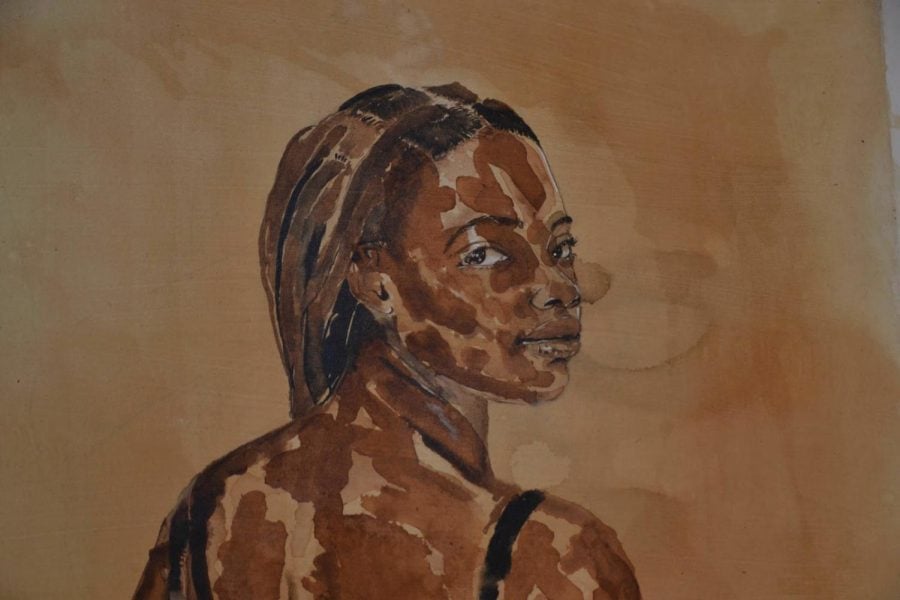‘Découverte: Her Diasporan Chronicles of Self Discovery’ exhibit highlights Black women and beauty
Jack Austin/Daily Senior Staffer
A close up image of a tea painting made by Laju Sholola, a Nigerian artist featured in an Evanston Art Center exhibit with Nigerian Canadian artist Ojo Agi.
May 14, 2023
Evanston Art Center’s “Découverte: Her Diasporan Chronicles of Self Discovery” exhibit explores the identity of Black women from the context of the greater Black diaspora. The most recent lobby gallery exhibit, which opened May 6 and runs through May 21, features Nigerian artist Laju Sholola and Nigerian Canadian artist Ojo Agi.
Show curator and Evanston-based artist Fran Joy said she paired the artists due to their aesthetics, with both using similar brown tones in their art. Both also have a Nigerian woman’s perspective. Joy said she appreciates art highlighting the beauty of Black women because Black girls throughout the diaspora often grow up teased about their skin and hair.
“Both of these artists are about discovery as a Black woman,” Joy said. “What it said to me was, ‘We are beautiful, we are gorgeous, I feel good about myself.’”
Patricia Andrews-Keenan, founder of Pigment International, a Chicago-based multimedia publication that reports on Black arts in the African diaspora, attended a gallery reception for the exhibit Saturday.
She said Black representation in art allows Black individuals to see themselves in spaces they had thought were closed off to them. This barrier was not limited to the visual arts.
“I would go to flea markets, and I would find sheet music derogatory,” Andrews-Keenan said. “To see the evolution, to see these kinds of representations … (They have) made all kinds of strides.”
Sholola said she puts part of herself and people who look like her into her paintings, which uses the unique medium of tea to create a spectrum of brown hues. Specifically, she paints skin tones and hair textures similar to hers to tell her own story.
Agi also employs unconventional artistic techniques. She started her career in cartoons and comics and said she struggled to draw Black characters on white paper. To remedy this, Ojo began buying brown paper to use as the base, and as a result, the skin color of her portraits now better suit the background. Using brown paper is part of a process of simply finding “spaces to exist” as a Nigerian Canadian, Agi said.
During the pandemic, Agi created seven portraits of Black women with a diversity of hairstyles and textures as a cathartic process. Two of them appear in the show.
Chicago resident and Liberian American Massa Massaley said it’s important to showcase beautiful Black women in art to combat negative stereotypes.
Massaley said she could see herself in the artwork on display and added she felt happiness looking at the images. She also appreciated the innovative technical approaches to painting Black people the artists developed, she said.
Joy said “Untitled (bob)” — named for the hairstyle — was her favorite because it looks like “serenity” and a confident version of herself. She added she later “fell in love” with Agi’s other featured piece, “Untitled (bun),” because she resonated with the frustration and strength displayed in the portrait.
“The value inside and thinking good of yourself when others don’t (comes through). Because Black worldwide is Black,” Joy said. “What they see first is your skin. And we have to live with that, and it takes a toll. So I appreciate (Agi and Sholola’s) creative value.”
Ogechi Harry, Agi and Sholola’s representative and founder of Golden Our Collective, an art agency aiming to promote Black creatives, said despite the distinct forms and materials of the two artists, they unite the viewer on a journey.
According to Harry, the two artists offer stories not often told about women of African descent.
“We’re talking about vulnerabilities. We’re talking about victories,” Harry said. “We’re talking about power and strength. I mentioned before placemaking and sort of understanding where you fit in.”
Sholola said she wants viewers to be able to imagine the lives of the Black individuals she depicts and understand themselves better in the process.
Agi’s work to uplift Black women through art came as a result of feeling disempowered; in her studies, she found racism and sexism to be barriers to health. Art gave her agency to protest what she saw as injustice.
“I was really astounded by the beauty of both artists’ work,” Massaley said. “These paintings can be very inspirational for Black women.”
Email: [email protected]
Twitter: @JackAustinNews
Related Stories:
— Eli Williamson’s ‘Four Virtues’ exhibit highlights loving Black fathers
— ‘Black History/My History’ celebrates diverse experiences of Blackness



